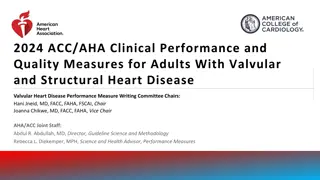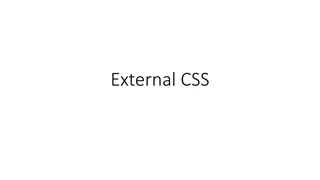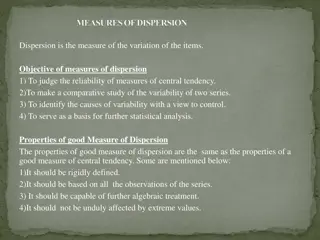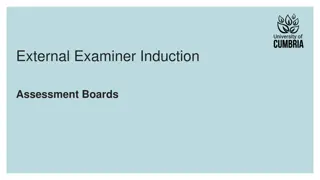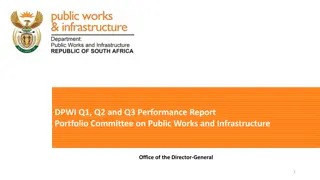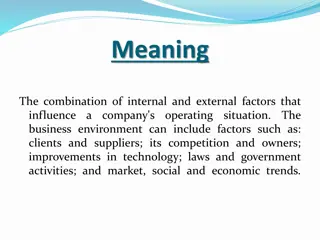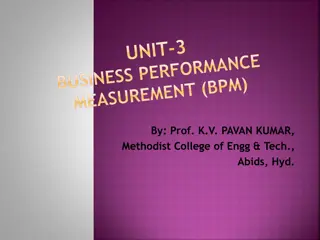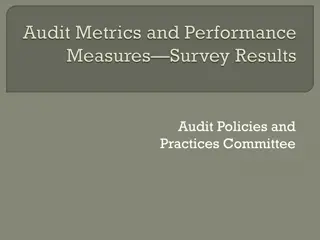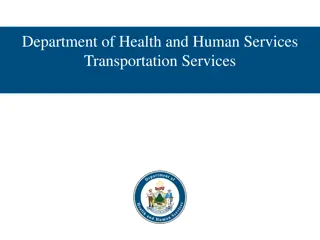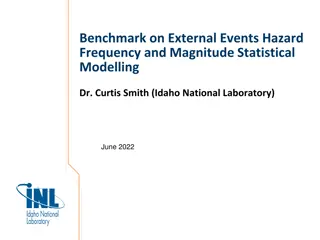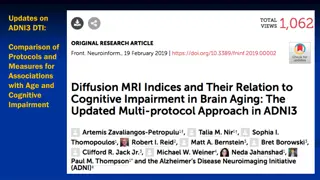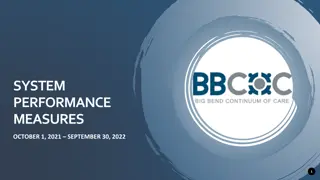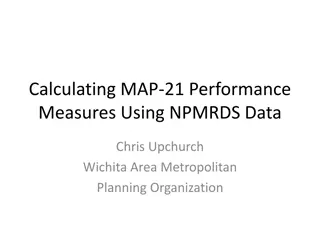
WorkFirst Performance Measures and Family Exit Trends
Explore WorkFirst program performance measures for the first quarter of 2025, including key statistics on program exits, employment, and earnings. Understand the state and federal statutes governing WorkFirst measures and the reasons for families exiting the program from 2017 to 2024. Dive into data on families exiting due to earnings and the trends over the specified period.
Download Presentation

Please find below an Image/Link to download the presentation.
The content on the website is provided AS IS for your information and personal use only. It may not be sold, licensed, or shared on other websites without obtaining consent from the author. If you encounter any issues during the download, it is possible that the publisher has removed the file from their server.
You are allowed to download the files provided on this website for personal or commercial use, subject to the condition that they are used lawfully. All files are the property of their respective owners.
The content on the website is provided AS IS for your information and personal use only. It may not be sold, licensed, or shared on other websites without obtaining consent from the author.
E N D
Presentation Transcript
WorkFirst Performance Measures First Quarter 2025 Produced on January 27, 2025
State and Federal Statutes Governing WorkFirst Performance Measures State statute calls for WorkFirst performance measures for use in program evaluation (RCW 74.08A.400 & 74.08A.410). Measures suggested in statute include: Program exits Employment, job retention, and earnings Performance measures by contractor/partner must be reported quarterly (RCW 74.08A.410) Fiscal Responsibility Act of 2023 (H.R. 3746) requires states to report metrics related to employment and earnings after program exit
Performance Measures for Families and Adults Exiting WorkFirst
WorkFirst Families Reasons for Exit January 2017 September 2024 70% 60% 50% 40% 30% 20% 10% 0% Sep-2017 Sep-2018 Sep-2019 Sep-2020 Sep-2021 Sep-2022 Sep-2023 Mar-2017 Nov-2017 Mar-2018 Nov-2018 Mar-2019 Nov-2019 Mar-2020 Nov-2020 Mar-2021 Nov-2021 Mar-2022 Nov-2022 Mar-2023 Nov-2023 Mar-2024 May-2017 May-2018 May-2019 May-2020 May-2021 May-2022 May-2023 May-2024 Jan-2017 Jan-2018 Jan-2019 Jan-2020 Jan-2021 Jan-2022 Jan-2023 Jan-2024 Jul-2017 Jul-2018 Jul-2019 Jul-2020 Jul-2021 Jul-2022 Jul-2023 Exit Month Exceeded Earned Income Limit (RC 334) Other Income (RC 324, 331, 507) Requested Closure (RC 557) All Other Closure Reasons Note: Exit is defined as case closure followed by three months with no TANF/SFA receipt. Exits are measured at the household or assistance unit level. Only households with adult recipients participate in WorkFirst. The last month that the household received a TANF/SFA issuance is the exit month. The percentages in each month add up to 100%. The spike in Other Income exits from March 2020 to September 2021 is due to pandemic Unemployment Insurance benefits; the June 2023 spike in All Other Closure Reasons reflects the first month that the 60-month time limit was enforced after the pandemic. Reason codes (RCs) are used to explain why cases close. Source: ESA-EMAPS using the ACES Data Warehouse as of January 2025 Washington State Department of Social and Health Services
WorkFirst Families Number Exiting Due to Earnings October 2022 September 2024 766 759 732 731 726 724 706 705 684 680 679 676 673 671 661 650 634 629 609 570 567 533 520 512 Exit Month Note: Exit is defined as case closure followed by three months with no TANF/SFA receipt. Exits are measured at the household or assistance unit level. Only households with adult recipients participate in WorkFirst. The last month that the household received a TANF/SFA issuance is the exit month. Exiting due to earnings is defined as an exit with a 334 Exceeded Earned Income Limit reason code. Source: ESA-EMAPS using the ACES Data Warehouse as of January 2025 Washington State Department of Social and Health Services
WorkFirst Adults Employed at Exit Exit Quarter and First Quarter after Exit 6,000 70% 57.6% Q2 2019 # Employed % Employed 53.2% Q1 2017 60% 44.3% Q1 2024 5,000 44.2% Q1 2021 50% 4,000 3,923 3,817 40% 3,686 3,660 3,518 3,517 3,462 3,377 3,346 3,000 3,330 3,323 3,321 3,309 3,260 3,152 3,149 3,129 3,082 3,008 30% 2,859 2,836 2,784 2,622 2,473 2,412 2,410 2,378 2,000 2,326 2,226 20% 1,000 10% 0 0% Q1 2017 Q2 Q3 Q4 Q1 2018 Q2 Q3 Q4 Q1 2019 Q2 Q3 Q4 Q1 2020 Q2 Q3 Q4 Q1 2021 Q2 Q3 Q4 Q1 2022 Q2 Q3 Q4 Q1 2023 Q2 Q3 Q4 Q1 2024 Exit Quarter (Calendar Year) Note: Exit is defined as at least one month with a TANF/SFA issuance followed by at least three months with no TANF/SFA issuance. The exit quarter includes the last month of TANF/SFA receipt. For percent employed, the denominator is the number of adults who exited TANF/SFA during the listed quarter; the numerator is the number of those exiting adults who had any employment recorded in the Unemployment Insurance (UI) system in either the exit quarter or the quarter after exit. Source: ESA-EMAPS using the ACES Data Warehouse as of January 2025 and ESD s UI wage data Washington State Department of Social and Health Services
WorkFirst Adults Employment & Earnings Second Quarter after Exit 49.7% Q1 2022 47.9% Q1 2017 $10,000 55% 50% 41.0% Q4 2023 37.3% Q3 2020 45% $8,000 40% Median Quarterly Earnings % Employed $7,442 $7,363 $7,159 $6,958 35% $6,746 $6,671 $6,561 $6,553 $6,000 30% $5,864 $5,815 $5,551 $5,542 $5,367 $5,258 $5,235 $5,197 $5,195 25% $5,079 $4,875 $4,873 $4,852 $4,757 $4,731 $4,608 $4,000 $4,545 $4,525 $4,371 $4,220 20% 15% $2,000 10% 5% $0 0% Q1 2017 Q2 Q3 Q4 Q1 2018 Q2 Q3 Q4 Q1 2019 Q2 Q3 Q4 Q1 2020 Q2 Q3 Q4 Q1 2021 Q2 Q3 Q4 Q1 2022 Q2 Q3 Q4 Q1 2023 Q2 Q3 Q4 Exit Quarter (Calendar Year) Note: Exit is defined as at least one month with a TANF/SFA issuance followed by at least three months with no TANF/SFA issuance. The exit quarter includes the last month of TANF/SFA receipt. For percent employed, the denominator is the number of adults who exited TANF/SFA during the listed quarter; the numerator is the number of those exiting adults who had any employment recorded in the Unemployment Insurance (UI) system in the second quarter after exit. Median earnings are based on earnings recorded in the UI system in the second quarter after exit. Those with no earnings in the quarter are excluded. Source: ESA-EMAPS using the ACES Data Warehouse as of January 2025 and ESD s UI wage data Washington State Department of Social and Health Services
WorkFirst Adults Employment Retention & Earnings Fourth Quarter after Exit 83.0% Q3 2021 78.9% Q2 2023 76.4% Q1 2017 $10,000 90% 70.8% Q2 2019 80% $8,000 $8,408 70% Median Quarterly Earnings % Retained Employment $8,302 $8,198 $8,125 $7,710 $7,389 $7,386 $7,340 60% $7,125 $7,007 $6,933 $6,844 $6,789 $6,000 $6,442 $6,329 $6,161 50% $6,120 $5,901 $5,895 $5,891 $5,765 $5,628 $5,624 $5,494 $5,314 $5,038 40% $4,000 30% 20% $2,000 10% $0 0% Q1 2017 Q2 Q3 Q4 Q1 2018 Q2 Q3 Q4 Q1 2019 Q2 Q3 Q4 Q1 2020 Q2 Q3 Q4 Q1 2021 Q2 Q3 Q4 Q1 2022 Q2 Q3 Q4 Q1 2023 Q2 Exit Quarter (Calendar Year) Note: Exit is defined as at least one month with a TANF/SFA issuance followed by at least three months with no TANF/SFA issuance. The exit quarter includes the last month of TANF/SFA receipt. For percent retained employment, the denominator is the number of adults who exited TANF/SFA during the listed quarter and had any employment recorded in the Unemployment Insurance (UI) system in the second quarter after exit. The numerator is the number of those exiting adults who had any employment recorded in the UI system in the fourth quarter after exit. Median earnings are based on earnings recorded in the UI system in the fourth quarter after exit. Those with no earnings in the quarter are excluded. Source: ESA-EMAPS using the ACES Data Warehouse as of January 2025 and ESD s UI wage data Washington State Department of Social and Health Services
WorkFirst Adults Exits Lasting At Least One Year January 2017 December 2023 85.5% May 2020 74.3% Dec 2023 76.5% Jan 2017 67.1% Oct 2019 Mar-2017 Mar-2018 Mar-2019 Mar-2020 Mar-2021 Mar-2022 Mar-2023 Sep-2017 Sep-2018 Sep-2019 Sep-2020 Sep-2021 Sep-2022 Sep-2023 Nov-2017 Nov-2018 Nov-2019 Nov-2020 Nov-2021 Nov-2022 Nov-2023 May-2017 May-2018 May-2019 May-2020 May-2021 May-2022 May-2023 Jan-2017 Jan-2018 Jan-2019 Jan-2020 Jan-2021 Jan-2022 Jan-2023 Jul-2017 Jul-2018 Jul-2019 Jul-2020 Jul-2021 Jul-2022 Jul-2023 Note: Exit is defined as at least one month with a TANF/SFA issuance followed by at least one month with no TANF/SFA issuance. The exit month is the last month of TANF/SFA receipt. The denominator is the number of adults who exited TANF/SFA in the listed month; the numerator is the number of those exiting adults who did not return to TANF/SFA for at least 12 months following that exit. Source: ESA-EMAPS using the ACES Data Warehouse as of January 2025 Washington State Department of Social and Health Services
Performance Measures for Adults Exiting WorkFirst Service Pathways
Employment after Exiting WorkFirst Service Pathway Percent Employed in Second Quarter after Pathway Exit 65% 60% 55% 50% 45% 40% 35% 30% Q1 2017 Q2 Q3 Q4 Q1 2018 Q2 Q3 Q4 Q1 2019 Q2 Q3 Q4 Q1 2020 Q2 Q3 Q4 Q1 2021 Q2 Q3 Q4 Q1 2022 Q2 Q3 Q4 Q1 2023 Q2 Q3 Q4 Exit Quarter (Calendar Year) Employment Security Job Search Vocational or Postsecondary Education Community Jobs LEP Job Search Note: Exiting WorkFirst service pathway is defined as not being enrolled in the WorkFirst service pathway for three months after being enrolled for at least one month. The exit quarter includes the last month of enrollment in the WorkFirst service pathway. The denominator is the number of adults who exited that WorkFirst service pathway during the listed quarter; the numerator is the number of those exiting adults who had any employment recorded in the Unemployment Insurance (UI) system in the second quarter after exit. Source: ESA-EMAPS using the ACES Data Warehouse as of January 2025 and ESD s UI wage data Washington State Department of Social and Health Services
Quarterly Earnings after Exiting WorkFirst Service Pathway Median Quarterly Earnings in Second Quarter after Pathway Exit $11,000 $10,000 $9,000 $8,000 $7,000 $6,000 $5,000 $4,000 $3,000 Q1 2017 Q2 Q3 Q4 Q1 2018 Q2 Q3 Q4 Q1 2019 Q2 Q3 Q4 Q1 2020 Q2 Q3 Q4 Q1 2021 Q2 Q3 Q4 Q1 2022 Q2 Q3 Q4 Q1 2023 Q2 Q3 Q4 Exit Quarter (Calendar Year) Employment Security Job Search Vocational or Postsecondary Education Community Jobs LEP Job Search Note: Exiting WorkFirst service pathway is defined as not being enrolled in the WorkFirst service pathway for three months after being enrolled for at least one month. The exit quarter includes the last month of enrollment in the WorkFirst service pathway. Median earnings are based on earnings recorded in the Unemployment Insurance (UI) system in the second quarter after exit. Those with no earnings in the quarter are excluded. Adults in LEP Job Search typically work more hours in the quarter than adults in the other three pathways. Source: ESA-EMAPS using the ACES Data Warehouse as of January 2025 and ESD s UI wage data Washington State Department of Social and Health Services
Hourly Wages after Exiting WorkFirst Service Pathway Median Hourly Wages in Second Quarter after Pathway Exit $24 $22 $20 $18 $16 $14 $12 $10 Q1 2017 Q2 Q3 Q4 Q1 2018 Q2 Q3 Q4 Q1 2019 Q2 Q3 Q4 Q1 2020 Q2 Q3 Q4 Q1 2021 Q2 Q3 Q4 Q1 2022 Q2 Q3 Q4 Q1 2023 Q2 Q3 Q4 Exit Quarter (Calendar Year) Employment Security Job Search Community Jobs State Minimum Wage Vocational or Postsecondary Education LEP Job Search Note: Exiting WorkFirst service pathway is defined as not being enrolled in the WorkFirst service pathway for three months after being enrolled for at least one month. The exit quarter includes the last month of enrollment in the WorkFirst service pathway. Median hourly wage is based on earnings and hours worked recorded in the Unemployment Insurance (UI) system in the second quarter after exit. Those with no earnings or hours worked in the quarter are excluded. State minimum wage reflects the minimum wage in effect two quarters after the quarter listed on the horizontal axis. Source: ESA-EMAPS using the ACES Data Warehouse as of January 2025 and ESD s UI wage data Washington State Department of Social and Health Services
Enrollment Counts for WorkFirst Adults
WorkFirst Adults Referrals by Partner January 2017 December 2024 3,500 3,000 2,500 2,000 1,500 1,000 500 0 Mar-2017 Mar-2018 Mar-2019 Mar-2020 Mar-2021 Mar-2022 Mar-2023 Mar-2024 Nov-2017 Nov-2018 Nov-2019 Nov-2020 Month Nov-2021 Nov-2022 Nov-2023 Nov-2024 Jan-2017 Sep-2017 Jan-2018 Sep-2018 Jan-2019 Sep-2019 Jan-2020 Sep-2020 Jan-2021 Sep-2021 Jan-2022 Sep-2022 Jan-2023 Sep-2023 Jan-2024 Sep-2024 May-2017 Jul-2017 May-2018 Jul-2018 May-2019 Jul-2019 May-2020 Jul-2020 May-2021 Jul-2021 May-2022 Jul-2022 May-2023 Jul-2023 May-2024 Jul-2024 Employment Security Community & Technical Colleges Commerce ORIA Note: Referrals are based on the contractor referral date occurring during the reporting month. Employment Security referrals are those referred to Job Search Preparation (RI), Job Search (JS), Life Skills Training (LS), or On the Job Training (OT) without a contractor. Community & Technical Colleges referrals are those referred to an SBCTC contractor for Community/Technical College (RA), Vocational Education (VE), Skills Enhancement Training (JT), High Wage or High Demand (HW), High School (HS), High School Equivalency (GE), or Degree Completion (DC). Commerce referrals are those referred to a Commerce contractor for Community Jobs (CJ), Job Connection (JC), Community Works (WC,CW), or Work Experience (WE). ORIA referrals are those referred to an ORIA contractor for English as a Second Language (ES), Limited English Pathway (LP), Skills Enhancement Training (JT), Work Experience (WE), Job Search (JS), Working Part-Time (PT), or Working Full-Time (FT). Source: ESA-EMAPS using the ACES Data Warehouse as of January 2025 Washington State Department of Social and Health Services
WorkFirst Adults Enrollment by Partner January 2017 December 2024 6,000 5,000 4,000 3,000 2,000 1,000 0 Mar-2017 Mar-2018 Mar-2019 Mar-2020 Mar-2021 Mar-2022 Mar-2023 Mar-2024 Nov-2017 Nov-2018 Nov-2019 Nov-2020 Month Nov-2021 Nov-2022 Nov-2023 Nov-2024 Jan-2017 Sep-2017 Jan-2018 Sep-2018 Jan-2019 Sep-2019 Jan-2020 Sep-2020 Jan-2021 Sep-2021 Jan-2022 Sep-2022 Jan-2023 Sep-2023 Jan-2024 Sep-2024 May-2017 Jul-2017 May-2018 Jul-2018 May-2019 Jul-2019 May-2020 Jul-2020 May-2021 Jul-2021 May-2022 Jul-2022 May-2023 Jul-2023 May-2024 Jul-2024 Employment Security Community & Technical Colleges Commerce ORIA Note: For Commerce, Community and Technical Colleges, and LEP/ORIA, counts are based on contractor type as listed in eJAS. Because Employment Security contractors do not have a contractor type, they are defined as those in the JS (job search), OT (on-the-job training), and RI (job search preparation) components without a contractor type. Source: ESA-EMAPS using the ACES Data Warehouse as of January 2025 Washington State Department of Social and Health Services
WorkFirst Adults Enrollment by WorkFirst Service Pathway January 2017 December 2024 2,500 2,000 1,500 1,000 500 0 Mar-2017 Mar-2018 Mar-2019 Mar-2020 Mar-2021 Mar-2022 Mar-2023 Mar-2024 Nov-2017 Nov-2018 Nov-2019 Nov-2020 Month Nov-2021 Nov-2022 Nov-2023 Nov-2024 Sep-2017 Sep-2018 Sep-2019 Sep-2020 Sep-2021 Sep-2022 Sep-2023 Sep-2024 Jan-2017 Jul-2017 Jan-2018 Jul-2018 Jan-2019 Jul-2019 Jan-2020 Jul-2020 Jan-2021 Jul-2021 Jan-2022 Jul-2022 Jan-2023 Jul-2023 Jan-2024 Jul-2024 May-2017 May-2018 May-2019 May-2020 May-2021 May-2022 May-2023 May-2024 Employment Security Job Search Vocational or Postsecondary Education Community Jobs LEP Job Search Note: These numbers reflect WorkFirst adults enrolled in each WorkFirst service pathway in the listed month. Adults may be enrolled in more than one WorkFirst service pathway in each month; they are counted once per month for each WorkFirst service pathway. Source: ESA-EMAPS using the ACES Data Warehouse as of January 2025 Washington State Department of Social and Health Services
WorkFirst Adults Enrollment in Educational Activities January 2017 December 2024 19.8% Jan 2017 6,000 25% # Enrolled in Educational Activities 21.1% Apr 2017 % Enrolled in Educational Activities 5,000 20% 4,000 15% 3,000 13.5% Dec 2024 10% 4.2% Jul 2021 2,000 5% 1,000 0 0% Oct-2017 Oct-2018 Oct-2019 Oct-2020 Month Oct-2021 Oct-2022 Oct-2023 Oct-2024 Jan-2017 Jan-2018 Jan-2019 Jan-2020 Jan-2021 Jan-2022 Jan-2023 Jan-2024 Apr-2017 Apr-2018 Apr-2019 Apr-2020 Apr-2021 Apr-2022 Apr-2023 Apr-2024 Jul-2017 Jul-2018 Jul-2019 Jul-2020 Jul-2021 Jul-2022 Jul-2023 Jul-2024 Note: Enrollment in educational activities is defined as enrollment in at least one of the following component codes: BE (Basic Education), ES (English as a Second Language), GE (High School Equivalency), HS (High School), DC (Degree Completion), HW (High Wage or High Demand), JT (Skills Enhancement Training), PE (Customized Job Skills Training), VE (Vocational Education), and VU (Vocational Education - Unapproved) component codes. WorkFirst adults may be enrolled in more than one educational activity in each month, but each adult is only counted once per month. Source: ESA-EMAPS using the ACES Data Warehouse as of January 2025 Washington State Department of Social and Health Services
WorkFirst Adults Enrollment by Type of Educational Activity January 2023 December 2024 6,000 5,000 4,000 3,000 2,000 1,000 0 Month # Enrolled in English as a Second Language # Enrolled in High School/GED Completion # Enrolled in Postsecondary Education/Training # Enrolled in Basic Education # Enrolled in Vocational Education Note: English as a Second Language includes the ES (English as a Second Language) component code, and Basic Education includes the BE (Basic Education) component code. High School/GED Completion includes the GE (High School Equivalency) and HS (High School) component codes. Vocational Education includes the VE (Vocational Education) and VU (Vocational Education - Unapproved) component codes. Postsecondary Education/Training includes the DC (Degree Completion), HW (High Wage or High Demand), JT (Skills Enhancement Training), and PE (Customized Job Skills Training) component codes. WorkFirst adults may be enrolled in more than one educational activity in each month, but each adult is only counted once per month per category. Source: ESA-EMAPS using the ACES Data Warehouse as of January 2025 Washington State Department of Social and Health Services
For any additional questions, please contact: Lisa Nicoli ESA Management Analytics and Performance Statistics (EMAPS) Economic Services Administration (ESA) Department of Social and Health Services (DSHS) lisa.nicoli@dshs.wa.gov



